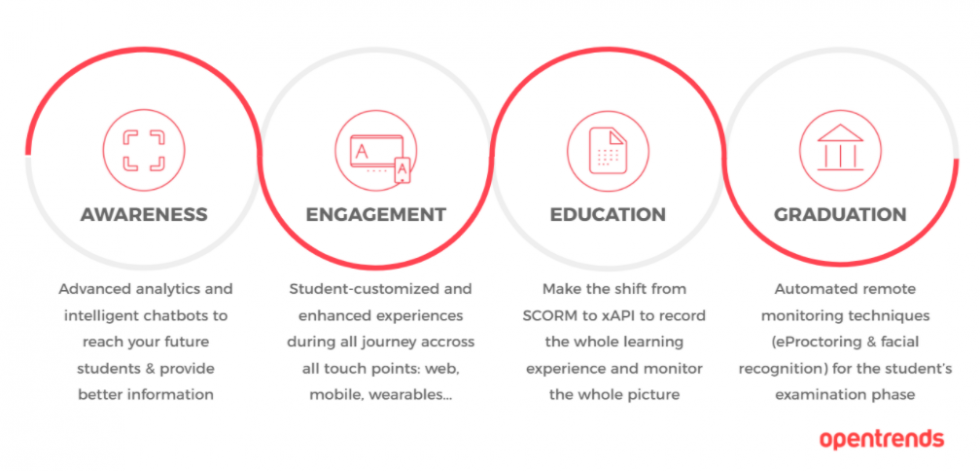
Hybrid learning in the post-covid era
The education sector has changed and there is no going back. A new global survey by the World Economic Forum reveals that seven out of ten adults worldwide (72%) think that, in five years, higher education will be done online at least as much as on-site. Specifically, almost a quarter of adults worldwide (23%) believe that in five years, higher education in their country will be carried out entirely or mostly, online. The other half (49%) believe it will take place both online and on-site.
Now that countries are carrying out vaccination processes, it is time to think about the post-pandemic world. The survey’s results reflect that we already sense that some things will not probably be the same again. Priorities will change: while a year ago the main challenge was to guarantee the continuity of learning processes through different “non-classroom” methodologies, today there is the additional challenge of implementing a hybrid model (blended) that includes a combination of face-to-face and non-face-to-face learning (eLearning) schemes.
For the student, the main benefit of this new approach is the flexibility of being able to carry out both face-to-face and asynchronous follow-up classes if they need, for example, to combine them with a work schedule (it is very important to think about students of all types and ages, as we will all be lifelong learners). From the universities’ point of view, the fact of being able to attract students who can follow their classes from anywhere in the world can be a real revolution.
The implications are far reaching. How to meet students’ expectations for perfect digital experiences? How to compete in a new, much more globalized context? How to move from an basically face-to-face student recruitment model to a new digital context? Not to mention the classroom’s digitalization, the digital transformation of educational content, assessment processes, etc. This year, more than ever, the education sector faces a real challenge. In fact, we could be at the beginning of a colossal process of transformation of the entire sector.
To respond to this environment of student's new expectations, the most successful universities will be those whose operations are fully digitized and respond to student demands for each and every one of their interactions.
The following image shows an approach to this transformation along the learner journey: initial awareness, engagement & omnichannel, educational process, and assessment and graduation.

- Awareness: The key to successfully manage the recruitment process will be double. On the one hand, students must be well-informed, having access to the right information at the right time; universities can help them to make decisions, for example, by using chatbots and voice assistants to guide them through this process. Universities will have to rethink their business processes and embrace new marketing strategies in order to compete in the new context. On the other hand, educational institutions must be able to provide students with a digital experience from the outset, an experience focused on self-service and automation that will allow students to easily navigate through their admissions process.
- Engagement: To stand out in the new context, it will be needed to achieve a memorable digital experience for the students. This will not be possible without the value of customization, even for each particular student: it will be essential to work with "DXP" technologies that offer customization and 360 vision features of the user in order to offer an experience according to their needs and expectations. In addition, it must be kept in mind the importance of having a technology that facilitates the consistent and frictionless implementation of all solutions of educational institutions through different channels and types of mobile devices: from desktops and tablets, to smartphones and others.
- Education: Synchronous consumer tools must be enabled. These tools will allow to work with students following classes from the university and from home, interacting with each other and with the professor in real time. At the same time, it will be necessary to feed the asynchronous side for those students who prefer to connect later or to do a later review, for example using LMS-type tools. Rather than transforming physical content into digital format, as it was during the pandemic, it is necessary to consider the hybrid approach from the outset, that is, since the process of educational content creation. Learning Experience Platforms (LXP) will be hybrid.
Moreover, thanks to new eLearning standards such as xAPI, which allows storing a person's interactions with different online learning activities, data and insights will be obtained, providing a 360-degree view of the student interactions which, combined with AI techniques, will offer fully customized learning paths and recommendations. Interoperability is one of the keys to provide a unified and seamless experience for both the student and the professor.
- Assessment & graduation. The transformation of the educational process brings the challenge of remote assessment. In this sense, it is absolutely necessary to guarantee the identity, the absence of help or the non-impersonation of the student. In this case, the solution is eproctoring technology, which allows the digitalization of the assessment processes. This technology uses artificial intelligence and facial recognition to verify student’s identity and to monitor their activity during the exam, thus maintaining the same integrity and quality of face-to-face exams, even online. Finally, the generation of student degrees must also be digitized. In this field, blockchain technology is emerging as the new standard for issuing digital credentials by providing graduates with unique, employer verifiable, tamper-proof and lifetime tokens.
According to the results of the survey, the education sector is entering an era of disruption. The transformation of this sector is an immense challenge but, at the same time, it is an exciting opportunity. Those who know how to take advantage of it through the implementation of hybrid learning models with an intensive use of technology, focused on maximizing the value for the student throughout their learner journey, will be the best positioned for success.










